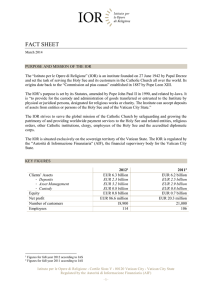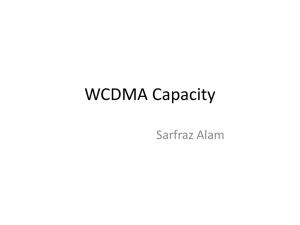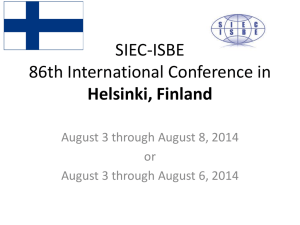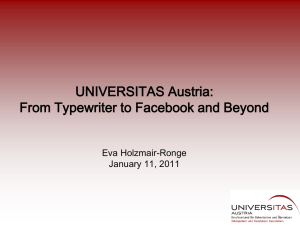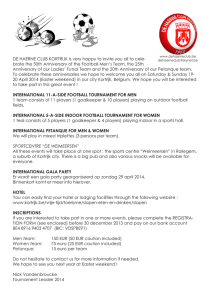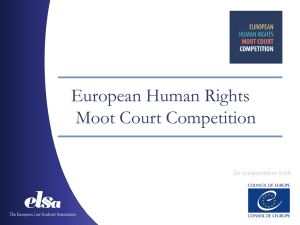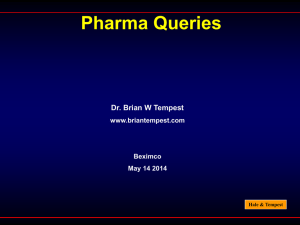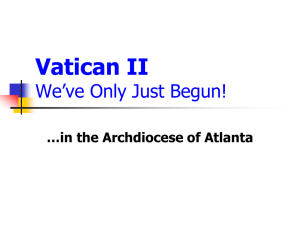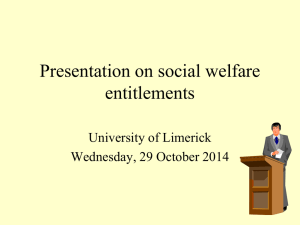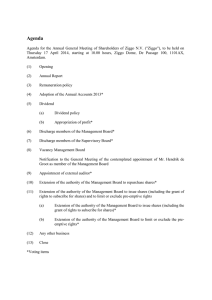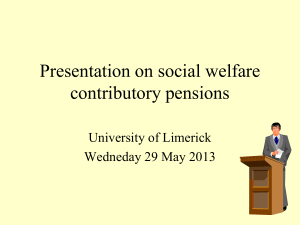Leggi l`articolo
advertisement
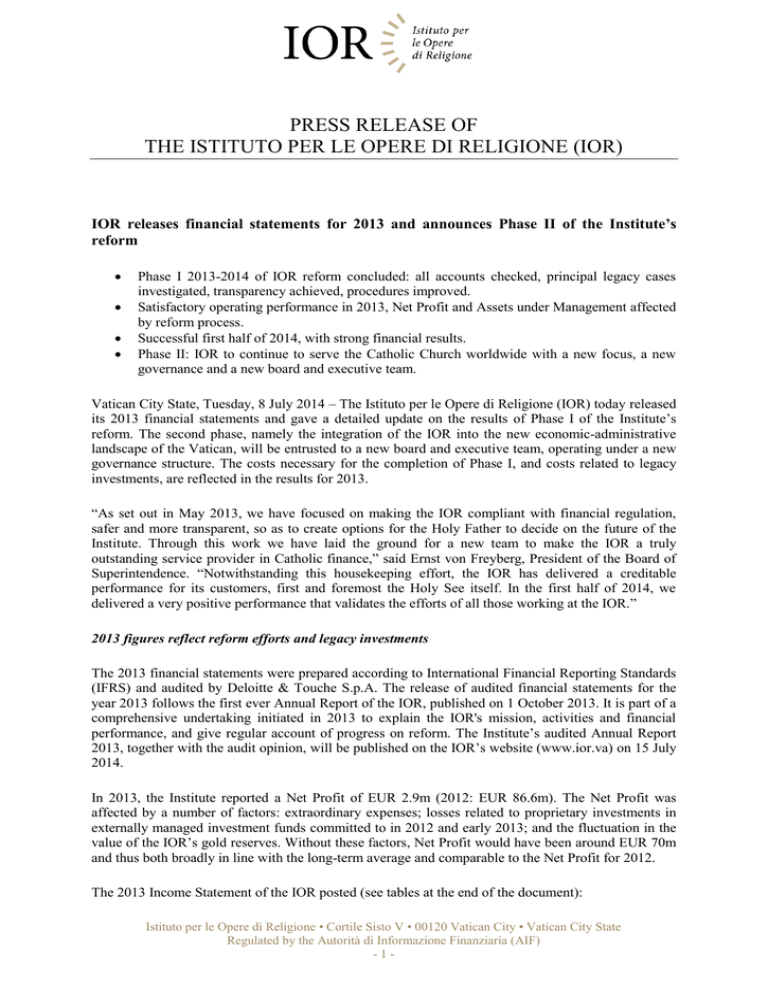
PRESS RELEASE OF THE ISTITUTO PER LE OPERE DI RELIGIONE (IOR) IOR releases financial statements for 2013 and announces Phase II of the Institute’s reform Phase I 2013-2014 of IOR reform concluded: all accounts checked, principal legacy cases investigated, transparency achieved, procedures improved. Satisfactory operating performance in 2013, Net Profit and Assets under Management affected by reform process. Successful first half of 2014, with strong financial results. Phase II: IOR to continue to serve the Catholic Church worldwide with a new focus, a new governance and a new board and executive team. Vatican City State, Tuesday, 8 July 2014 – The Istituto per le Opere di Religione (IOR) today released its 2013 financial statements and gave a detailed update on the results of Phase I of the Institute’s reform. The second phase, namely the integration of the IOR into the new economic-administrative landscape of the Vatican, will be entrusted to a new board and executive team, operating under a new governance structure. The costs necessary for the completion of Phase I, and costs related to legacy investments, are reflected in the results for 2013. “As set out in May 2013, we have focused on making the IOR compliant with financial regulation, safer and more transparent, so as to create options for the Holy Father to decide on the future of the Institute. Through this work we have laid the ground for a new team to make the IOR a truly outstanding service provider in Catholic finance,” said Ernst von Freyberg, President of the Board of Superintendence. “Notwithstanding this housekeeping effort, the IOR has delivered a creditable performance for its customers, first and foremost the Holy See itself. In the first half of 2014, we delivered a very positive performance that validates the efforts of all those working at the IOR.” 2013 figures reflect reform efforts and legacy investments The 2013 financial statements were prepared according to International Financial Reporting Standards (IFRS) and audited by Deloitte & Touche S.p.A. The release of audited financial statements for the year 2013 follows the first ever Annual Report of the IOR, published on 1 October 2013. It is part of a comprehensive undertaking initiated in 2013 to explain the IOR's mission, activities and financial performance, and give regular account of progress on reform. The Institute’s audited Annual Report 2013, together with the audit opinion, will be published on the IOR’s website (www.ior.va) on 15 July 2014. In 2013, the Institute reported a Net Profit of EUR 2.9m (2012: EUR 86.6m). The Net Profit was affected by a number of factors: extraordinary expenses; losses related to proprietary investments in externally managed investment funds committed to in 2012 and early 2013; and the fluctuation in the value of the IOR’s gold reserves. Without these factors, Net Profit would have been around EUR 70m and thus both broadly in line with the long-term average and comparable to the Net Profit for 2012. The 2013 Income Statement of the IOR posted (see tables at the end of the document): Istituto per le Opere di Religione • Cortile Sisto V • 00120 Vatican City • Vatican City State Regulated by the Autorità di Informazione Finanziaria (AIF) -1- EUR 53.8m (+3%) Net Interest Result, recording the spread between the yield received on assets and the interest paid to customers on deposits; EUR 14.1m (+16%) in Net Fees and Commissions, mainly on asset management; EUR 3.8m (+108%) in Dividends from securities; EUR -16.5m (2012: EUR 51.1m) in Net Trading Result, recording the realized gain or loss on the value of securities sold during the year as well as the unrealized profit and loss in the total value of securities and precious metals held on 31 December 2013. This position includes write-down of proprietary investments in external funds committed to between 2012 and early 2013 (EUR -28.5m) as well as the fluctuation in the market value of IOR’s gold reserves (EUR -11.5m); EUR -14.4m in Other Net Income (2012: EUR -4.7m), including a donation of securities with a book value of EUR 15.1m to a foundation of the Holy See; Operating Expenses totalled EUR 32.2m (2012: EUR 23.9m) and included staff expenses, pension contributions, general maintenance and professional fees. The increase of EUR 8.3m (+35%) was mainly due to expenses incurred in 2013 for professional services required for the Institute’s reorganisation and reform; EUR -5.7m in Impairment Losses (2012: EUR -2.1m) including a depreciation of EUR 3.2m on financial support provided to the Diocese of Terni. In 2013, the IOR contributed EUR 54m to the budget of the Holy See. In 2013, the total value of assets entrusted by customers to the IOR (including deposits, assets held in custody and assets held under portfolio management) fell by EUR 0.4bn to EUR 5.9bn (2012: EUR 6.3bn). These assets consisted of EUR 1.9bn (2012: EUR 2.3bn) in deposits, EUR 3.3bn (2012: EUR 3.2bn) managed by the IOR under asset management agreements and EUR 0.8bn (2012: EUR 0.8bn) in assets held for customers under custody agreements. Year-end 2013, the IOR’s Equity was recorded at EUR 720m (2012: EUR 769m), giving the Institute a solid Total Capital Ratio of 17.2%. Satisfactory first half 2014 The results for the period from 1 January to 30 June 2014 are based on the IOR’s internal management reporting and are preliminary. They are highly satisfactory, showing a Net Profit of EUR 57.4m. Net interest result, net fee and commission result and net trading result all developed well, while operating expenses were reduced compared to 2013. The IOR had an Equity of EUR 775.4m on 30 June 2014. This result is due to the Institute’s normal operations and includes the expenses for the reform process. As of 30 June 2014, the total value of the assets entrusted by customers to the IOR (including deposits, assets held in custody and assets held under portfolio management) had increased by EUR 0.1bn to EUR 6bn. Phase I of the IOR’s reform process concluded Istituto per le Opere di Religione • Cortile Sisto V • 00120 Vatican City • Vatican City State Regulated by the Autorità di Informazione Finanziaria (AIF) -2- Phase I of the IOR reform process initiated in April/May 2013 was built around three pillars: compliance, focus on church customers, and transparency. From May 2013 until June 2014, the IOR has been engaged in a systematic screening of all existing customer records in order to identify missing or insufficient information required for the completion of new customer identity data templates the Institute introduced in the second quarter 2013. That task has been concluded and the remaining missing information is currently being collected. Until completion of the required data templates, the IOR has as of now blocked the accounts of 1,329 individual clients and 762 institutional clients. Subsequent to the screening process and as per 30 June 2014, the IOR has terminated around 3,000 customer relationships, in an orderly process. These consisted of around 2,600 customer relationships recording a small balance and no activity for a long period (“dormant accounts”). In addition, 396 customer relations were ended due to the decision of the Board of Superintendence from 4 July 2013 to restrict the customer categories of the Institute. Thanks to this decision, the IOR now focuses only on catholic institutions, clerics, employees or former employees of the Vatican with salary and pension accounts, as well as embassies and diplomats accredited to the Holy See. The decision of the Board of Superintendence to define the customer categories more precisely was taken with a view to accelerate the reform process. In 2013 and first half of 2014, the ending of these 396 customer relationships led to an outflow of funds amounting to about EUR 44m. EUR 37.1m of those funds were transferred by wire to financial institutions in jurisdictions that ensure traceability of funds through an equivalent regulatory framework – 88% to Italian institutions. About EUR 5.7m was transferred internally as donations. The remaining amount of EUR 1.2m was paid out in cash and registered accordingly. A further 359 customer relationships that do not meet the criteria set by the Board of Superintendence in July 2013, with an overall balance of around EUR 183m as of year-end 2013, are earmarked for closure and are currently subject to the relevant closing process. As of 31 December 2013, the IOR had 17,419 customers (2012: approximately 18,900), of which 5,043 were Catholic institutions, accounting for more than 80% of Assets under Management, and 12,376 were individuals, accounting for less than 20%. The recorded decrease in customers corresponds with a decrease in overall Assets under Management of 5.9%. On 30 June 2014, the IOR served 15,495 customers and recorded overall customer assets of EUR 6bn. Legacy issues and adaptation to a new regulatory environment As a result of the overall operational review undertaken since May 2013 the management has identified a number of legacy investments which required extraordinary and precautionary write-down in year 2013. In addition, a series of special investigations led by the new management have improved transparency and enabled the Institute to actively address compliance risk by submitting the results to the competent Vatican authorities. "At the beginning of my mandate, I repeatedly said that I would proceed with zero tolerance for any suspicious activity. We have carried out our reforms in this spirit and have not only drastically Istituto per le Opere di Religione • Cortile Sisto V • 00120 Vatican City • Vatican City State Regulated by the Autorità di Informazione Finanziaria (AIF) -3- improved procedures to make the Institute safer and more transparent, but have also put the Institute’s owner in a position to act on the basis of facts,” said Ernst von Freyberg. “It is fair to say that over the past months this often painful but very necessary process has opened the door to a new, unburdened future of the IOR - as a financial service provider that is fully and solely dedicated to serving the mission of the Catholic Church.” A number of major regulatory changes affecting the IOR have been introduced to the Vatican City State/Holy See in 2013. Particularly Law XVIII of the Vatican City State on transparency, supervision and financial information, issued on 8 October 2013, is carrying a wide array of new provisions that the IOR has to adapt to. In line with its ongoing compliance programme (see IOR press release of 22 January 2014), and anticipating AIF regulation on the application of the new law, IOR has implemented a broad range of additional procedures and has strengthened existing processes. As a result of the first regular on-site inspection carried out by the Autorità di Informazione Finanziaria (AIF) in the first half of 2014, AIF is currently developing a schedule for the implementation of further improvements and adjustments. The efforts and substantial improvements in compliance were acknowledged by the Committee of Experts on the Evaluation of Anti-Money Laundering Measures and the Financing of Terrorism of the Council of Europe (MONEYVAL) in their evaluation of the Holy See published in December 2013. “I would like to thank Ernst von Freyberg and the entire Board, Ronaldo Schmitz, Carl Anderson, Antonio Maria Marrocco, Manuel Soto Serrano as well as Director General Rolando Marranci and his team for their great dedication to the cause of delivering a safe and professional financial service to the Church and in bringing about the required improvements for the continuation of that service,” said H.E. Cardinal George Pell, Prefect for the Economy. “After all their hard work, we are now in a position to move the IOR to a second phase of reform under new leadership.” Phase II: Future of the IOR Following the confirmation of the IOR’s mission by the Holy Father on 7 April 2014 and under the guidance of the Secretariat for the Economy and its Council, a plan on the future of the Institute has been developed. The Secretariat for the Economy and the IOR Supervisory Commission of Cardinals have jointly and unanimously agreed that this plan shall be carried out under a new governance structure and by a new board and executive team. The current management team has agreed to remain on board to ensure an orderly transition. “This is a time of major change in the Holy See, not only for the IOR. With the support of the Holy Father and the Council of Cardinals, we are creating simpler, more efficient structures for those serving the mission of the Catholic Church,” said Cardinal-Prefect George Pell. We are set to implement a series of changes to governance and operations that will ensure continuity of service in the context of a broader reform of the economic and administrative structures of the Holy See.” The Secretariat for the Economy will host a Press Conference this coming Wednesday, 9 July 2014, in Sala Stampa Vaticana to present the new IOR Board and provide an update on the key elements of Phase II of the Institute’s operational reform. Istituto per le Opere di Religione • Cortile Sisto V • 00120 Vatican City • Vatican City State Regulated by the Autorità di Informazione Finanziaria (AIF) -4- Summary Income Statement EUR 000 2013 2012 2011 Net interest result 53,812 52,172 64,928 Net fee and commission result Dividends 14,110 12,194 10,219 3,796 1,827 2,705 Net trading result (16,545) 51,128 (38,173) Other net income (expense) Operating Result (14,396) (4,653) 5,305 40,777 112,668 44,984 Operating expenses (32,187) (23,949) (20,957) Impairment losses (5,725) (2,104) (3,774) 2,865 86,615 20,253 Net Result Summary Balance Sheet EUR 000 2013 2012 2011 Cash and Bank deposits 715,990 1,221,548 1,442,260 Investment in securities 2,588,517 3,619,310 2,496,437 Other assets 86,510 144,898 128,829 Total assets 3,391,017 4,985,756 4,067,526 Due for savings accounts 2,544,278 4,103,473 3,224,981 Other liabilities 126,692 113,024 101,384 Total equity 720,047 769,259 741,161 3,391,017 4,985,756 4,067,526 Total liabilities equity and Istituto per le Opere di Religione • Cortile Sisto V • 00120 Vatican City • Vatican City State Regulated by the Autorità di Informazione Finanziaria (AIF) -5- Summary Overview on Clients’ Assets 2013 EUR 000 Carried on Balance Sheet Not carried on Balance Sheet 1,871,173 0 Management 673,105 2,645,328 Custody 0 758,842 2,544,278 3, 404,170 Deposits (incl. Accruals) Assets under agreements Assets under agreements Assets Total assets 5,948,448 About the Istituto per le Opere di Religione (IOR): The “Istituto per le Opere di Religione” (IOR) is an institute founded on 27 June, 1942, by Papal Decree to serve the Holy See and its customers in the Catholic Church all over the world. Its origins date back to the "Commissione ad Pias Causas" established in 1887 by Pope Leo XIII. The IOR’s purpose is set by its Statute, amended by Pope John Paul II in 1990, and related by-laws. It is “to provide for the custody and administration of goods transferred or entrusted to the Institute by physical or juridical persons, designated for religious works or charity. The Institute can accept deposits of assets from entities or persons of the Holy See and of the Vatican City State.” The IOR strives to serve the global mission of the Catholic Church by protecting and growing the patrimony of and providing worldwide payment services to the Holy See and related entities, religious orders, other Catholic institutions, clergy, employees of the Holy See and the accredited diplomatic corps. As of 31 December 2013, the IOR was entrusted with customers’ assets (including deposits, assets held in custody and assets held under portfolio management agreements) totalling EUR 5.9bn, and shareholders’ equity of EUR 720m. The IOR is situated exclusively on the sovereign territory of the Vatican City State. The IOR is supervised and regulated by the "Autorità di Informazione Finanziaria" (AIF), the financial supervisory body for the Vatican City State. Media Contact: Max Hohenberg Markus Wieser Tel./Mob.: +39 06 698 85 910 Email: press@ior.va For further information please visit us on: www.ior.va Istituto per le Opere di Religione • Cortile Sisto V • 00120 Vatican City • Vatican City State Regulated by the Autorità di Informazione Finanziaria (AIF) -6-
